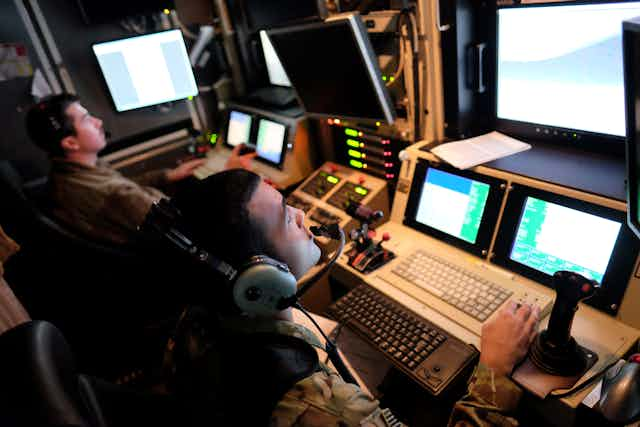The Australian Army’s top brass are assembled in Adelaide for the Land Forces 2016 conference. Cutting-edge military equipment, including autonomous vehicles associated with “hybrid warfare”, will be on display.
But what is hybrid warfare? Is it just another trendy term for an age-old phenomenon?
Pundits differ on answers. But, broadly speaking, it involves a fresh take on conventional warfighting, special operations (or irregular warfare) and advanced technology to hack, deceive or disable the adversary’s military capabilities.
Deceptive strategies
Hybrid warfare’s rise to fame follows recent developments by Russia and China. In Crimea and Ukraine, Russian troops hid insignia, denied formal military links to Moscow and applied special forces tactics.
Such tactics were developed during the Cold War for operations behind enemy lines: the oft-photographed “little green men”.
Rather than a new way of warfare, this marks a disconcerting return to the dynamics of great power competition. Plausible deniability adds to the uncertainty – the “fog” – that would make an adversary hesitate rather than respond decisively.
Russia’s hybrid warfare has echoes in the waters of east and southeast Asia. Here, China’s white “maritime law enforcement” ships (avoiding the grey colour scheme traditionally associated with navies) and paramilitary fisheries vessels abound.
In addition to machine guns, their weapons include grappling hooks, water cannons and reinforced bows for ramming, sinking and intimidating smaller wooden fishing vessels.
The fabled ancient Chinese strategist Sun Tzu would be proud. Such forces demonstrate “the acme of skill” by winning political and territorial objectives without formally triggering a war – at least not yet.
Meanwhile, hybrid tactics used on land by Russia involve elite special forces soldiers. Their tactics are designed to nudge – but not cross – the threshold that would invoke a heavy-handed military response from a country like the US. Essentially, this replicates age-old principles of deception and subterfuge to gain military advantage over an adversary.

Technological innovation
“Hybrid warfare” looks innovative and new. But what’s new is not so much the concept, but the specific technological features and the contexts in which they are applied.
Unsurprisingly, armed forces around the world are closely watching the interactions of micro-robotics, precisions munitions, tracking systems, semi-autonomous weapons and advanced methods of stealth and camouflage.
The thermal and visual signature of an armoured vehicle, for instance, can now be hidden from most sensors, while its lethality is greater than ever.
Innovative protection measures that provide a defensive bubble, akin to the anti-missile defence systems, are being field-tested. This was once the sole preserve of major warships.
As with the advent of self-driving vehicles in our cities, the future battlefield will look very different. It will feature unattended, semi- or fully autonomous ground, air, maritime, surface and subsurface vessels. These are becoming cheaper to access and easier to operate.
Pundits talk about future conflict involving fleets of semi-autonomous unattended vehicles, which would be under the direction of a mother-craft.
This could be an F-35 stealth fighter aircraft with its own armed unattended aerial vehicles.
It could be an armoured vehicle with tethered drones scouting ahead, able to strike with precision, or a submarine with a flotilla of unattended vessels operating where waters are shallow and risks higher.
Fully autonomous operations remain the most ethically problematic, but are still some time away from being fielded. Understandably, there are ethical concerns about what conundrums Australia might face in applying these capabilities.

The future of Australian defence
The Australian Defence Force (ADF), despite its critics, operates to the highest of ethical standards in armed conflicts. Unfortunately, several adversaries and potential adversaries have increasingly proven unwilling to adhere to the same standards.
Ethical issues associated with such new technologies, and how an adversary may choose to use them against the ADF or others it seeks to protect, require attention. The balance of benefit versus harm must be carefully considered.
Australians should understand the ADF is one of the smallest defence forces in the Asian region. Cheap, readily accessible, autonomous and armed systems are beginning to proliferate. Accordingly, the ADF needs to keep abreast of innovations in military tactics and equipment, and their ethical ramifications.
Though one of the most capable and advanced forces, the ADF’s technological edge is eroding fast. Keeping up with, if not ahead of, the curve is proving increasingly challenging. Australia’s boutique and sophisticated defence force may be required to operate in an environment where numerical and technical superiority is uncertain or even unlikely.
The prospect of cheap autonomous or semi-autonomous platforms, therefore, is an immensely appealing way to compensate for the inadequacies of a small but technically advanced force. One day we may be tasked with facing not just a hybrid war, but something more akin to what we used to call conventional war.

